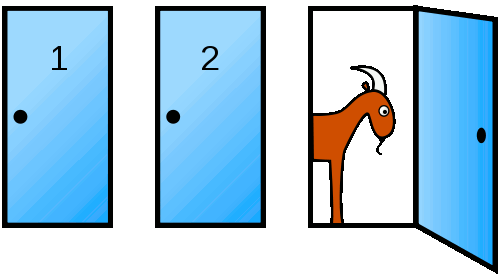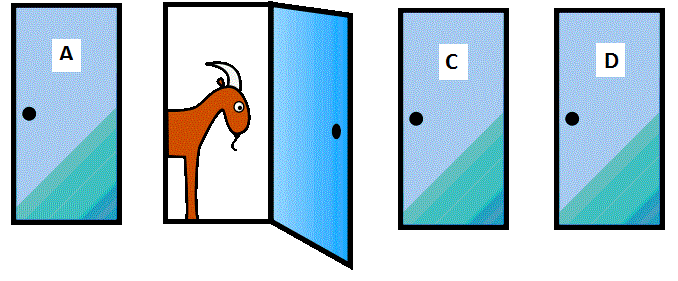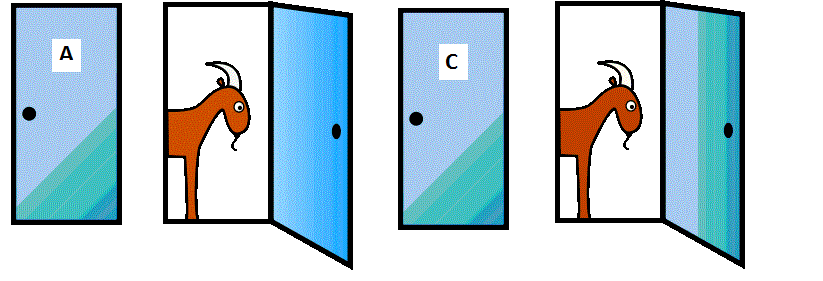Monty Hall could have lost 66.7% of times in the show, if contestant consistently took the best strategy. Could he reduce these losses and have made more money for the show?
Apparently, it boils down to how good he was with probablities!
Monty Halparin, also known as Monty Hall, hosted a game show in 1960’s called “Lets make a deal”. I have no doubt that the show minted billions of dollars over the years. The game has two levels – In the first level the maximum probability you can win is 33% which becomes 66% in the second round. Just imagine, that if audience knew the best strategy to approach this problem, host will lose 66% of times.
In this article, we will not touch up on the derivation of the Monty Hall’s problem as this is something thousands of people have studied and published. This article will serve as food for thought of digging even deeper into the same problem.
What happens if we add a door (making a total of 4 doors) and open 2 of them? This certainly makes the audience believe that their chances of winning increases further making the show even more interesting. But does the host lose more than 66% of times, if audience takes up the best strategy consistently. If not, probably the director should add a door in their show making it more interesting, making the deals longer and losing less number of times even against the best strategies.
[stextbox id=”section”] Actual Monty Hall’s problem : [/stextbox]
Suppose you’re on a game show, and you’re given the choice of three doors: Behind one door is a car (Ferrari, let’s say); behind the others – goats. You pick a door, say 1, and the host, who knows what’s behind the doors, opens another door, say 3, which has a goat. He then says to you, “Do you want to pick door 2?” Is it to your advantage to switch your choice?
[stextbox id=”section”] Simplistic solution : [/stextbox]
Following are the events :
[stextbox id=”grey”]A : door 1 has car B : door 2 has car C : door 3 has car
Co : Event that host opens door 3 and shows a goat
P(Co/C) = 0 (as host will never show the door with a car)
P(Co/A) = 0.5 ( as the contestant choose a door with car, host can show any of the doors 1 or 2 )
P(Co/B) = 1 ( host is left with no choice but open door 3)
P(A) = P(B) = P(C) =1/3 (all the events are equally likely)
Using Bayes theorem
P(Co) = 1/3*(0+1+0.5) = 0.5
P(A/Co) = (0.5*1/3) /0.5 = 1/3 = 33.34%
P(B/Co) = (1*1/3) / 0.5 = 2/3 = 66.67%
[/stextbox]
Hence, the contestant should switch the door raise his chances of winning from 33.34% to 66.67%. But notice, if contestant applies the best strategy the host would have lost 66.67% of times.
[stextbox id=”section”] Modified Monty Hall’s problem Part 1 :[/stextbox]
You’re given the choice of four doors: Behind one door is a car; behind the others, goats. You pick a door, say 1, and the host, who knows what’s behind the doors, opens another door, say 2, which has a goat. He then says to you, “Do you want to pick door 3 or 4?” What is your best strategy (lets say this choice 1)?
[stextbox id=”section”] Finding the best strategy to choice 1:[/stextbox]
Following are the events :
[stextbox id=”grey”]A : door A has car B : door B has car C : door C has car D : door D has car
Bo : Event that host opens door B and shows a goat
P(Bo/C) = P(Bo/D) = 1/2 (as host can show any of the door which does not have the car)
P(Bo/A) = 1/3 ( as the contestant choose a door with car, host can show any of the doors 1, 2 or 3 )
P(Bo/B) = 0 ( host cannot show the door with car behind it)
P(A) = P(B) = P(C) = P(D) = 1/4 (all the events are equally likely)
Using Bayes theorem
P(Bo) = 1/4*(0+0.5+0.5 + 0.333) = 1/3
P(A/Bo) = P(Bo/A)*P(A) / P(Bo) = (1/3 * 1/4) / (1/3) = 1/4 = 25%
P(C/Bo) = P(D/Bo) = 1/2(1-1/4) = 3/8 = 37.5% (By symmetry the two probabilities will be equal)
[/stextbox]
Hence, the best strategy as of now will be to shift to either door C or door D.
[stextbox id=”section”] Modified Monty Hall’s problem Part 2 :[/stextbox]
The host further opens up door D and shows a goat again. You are again asked if you want to make a shift back to door A or choose to stay at door C.
Finding the best strategy to choice 1:
[stextbox id=”grey”]Do : Event that host opens door D and shows a goat
P(Do/ A /Bo) = Probability of host opening door D given that B is already open and A has the car
= 1 (Host has no other choice)
P(Do/ C /Bo) = 0.5 (Host has a choice between A and D)
P(Do/ D /Bo) = 0
P(Do/Bo) = P(Do/ A / Bo)*P(A/Bo) + P(Do/C/Bo)*P(C/Bo) =1*1/4 + 3/8*1/2 = 7/16
P(C/Do/Bo) = (3/16) / (7/16) = 3/7 = 42.8%
P(A/Do/Bo) = 57.2%
[/stextbox]
Again, we see that the chances of winning a car is significantly increased if we make a switch from door C to door A. Note that we still have not explored the best strategy if host would have opened door A. If you do similar type of calculations in this revised scenario, you will see that the best strategy exist if you switch to door D. The chances of winning in this scenario becomes 66.67%.
On comparison of these two scenarios to original Monty Hall problem we see that the maximum of the probability of host losing in 4 door scenario is equal to 3 door scenario.Let’s think of the scenario in which the host is forced to open door A (which is a loss making proposal). The only case when host is bound to open door A is when participant originally chooses door A.
P(anchor losing in 4 door-2 open) = 0.25 * 66.67% + 0.75*57.2% = 59.6%
P(anchor losing in 3 door-1 open) = 66.67%
Note that we have left a scenario in which the participant sticks to his original door in the first scenario. This time the probability to win will come out higher than before but we will not touch up on this case. This is because this case assumes that the candidate is already aware that the host will open the second door after the participant chooses to stay with his first choice. In original Monty Hall’s problem the participant does not make his choice based on the knowledge that the host will open on of the other two doors. Imagine that you choose door A and host shows you a goat in door B. Now hosts asks you if you want to switch, and you choose to stay with the door A. Next moment, the host says “Looks like you really love door A, so let’s show you what is behind door A.” You obviously have only 25% of probability to win in this case.
[stextbox id=”section”] Summary of findings :[/stextbox]
We see that the probability of anchor losing is much lower in a 4 door scenario as compared to 3 door scenario. We have no intention to give recommendation to this legacy game show but will want to spark a discussion on the following : “If 4 door – 2 open Monty hall scenario gives a lesser probability of anchor losing compared to 3 door – 1 open scenario, certainly will excite the audience even more than the traditional Monty hall as it intensifies the illusion of winning on the wrong door and obviously consumes more time per contestant, then why did the show director restricted themselves to only 3 doors?” If the answer lies outside the world of probability, then its not worth initiating a debate on the same but if you have any inputs within the scope, do let us know your thoughts in the box below.









all depends on the related conditions. In the original 3-door problem this condition is: - the question is always done, the presentator has no personal interest of the result. Imagine the question would have been in 33,3% of the cases knowing the major price is behind that door. In the revised 4-door problem you did not mention the conditions. - Are the 2 questions always done, the presentator has no personal interest of the result. You can stick the first round and than switch. -> 75% is this allowed? You could switch the first round and than... Two options opening the original door or one of the first tree others. (not worked) out, interesting thoughts. The original 3 door is already having that much discussion as being counter intuitive. For sure the best action would switch at some moment.
Jaap, Here you do have an interesting thought and this is something I wanted to cover in the article in detail as well(however this is left as a note in the main article). But this would have made the article long and complicated. But because you brought this up, there are two scenarios in the 4 door puzzle. 1. You switch for the first time because this seems as that best solution at this point, and switch again in the second time : Probability to win is 59.6%. 2. You stick with the same door for the first time : Probability becomes higher in this case but in this case we are assuming that the participant knows that the host will show 2 doors with a goat after my first choice. Even in the original Monty Hall's the participant does not make his first choice based on the act that the host will show you a door after our choice. When you are given a choice for the first time, you should switch to increase your probability to win. An interesting thing you will notice here is that the first solution is a mixture of two local maxima which actually does not sum up to global maxima. Or simply put, solution 1 seems to be the best solutions in two different instances but 2 leads the participant to higher chances of winning. But still we will not consider case 2 as it assumes that the host will open one more door after your choice. Appreciate you bringing this up. Hope you enjoyed this exercise. Tavish
Tavish, I am not sure if your calculations are correct. If I understand correctly, the contender has four choices: 1. Stick with the door chosen initially, 2. Switch door after first opening and then stick with that door, 3. Stick with the door after first opening and then switch door, 4. Switch door after both openings. In case 1 the probability of a win is 0.25. (You win if you choose the car inititally). In case 2 you win if you choose a goat initially and then switch to the car, so the probability of a win is 0.75*0.5=0.375. In case 3 you win if you choose a goat initially, because when the second door opens, the car must be behind the door which was not chosen at first, so the probability of a win is 0.75. In case 4 you win if you choose the car initially, since after the first opening you switch to a goat and after the second opening you must switch back to the car. So if you chose the car initially you win with probability 1. If you choose a goat initially you win if you choose a goat after the first opening, because in that case you have to switch to the car after the second opening. So, if you first choose a goat, the probability of switching to another goat after the first door is opened is 0.5. Altogether, you win the car with probability 0.25*1+0.75*0.5=0.625. The best strategy is number 3 and it give you a higher probability to win than in the 3-door game. That might be the reason why they only had 3 doors in the show.